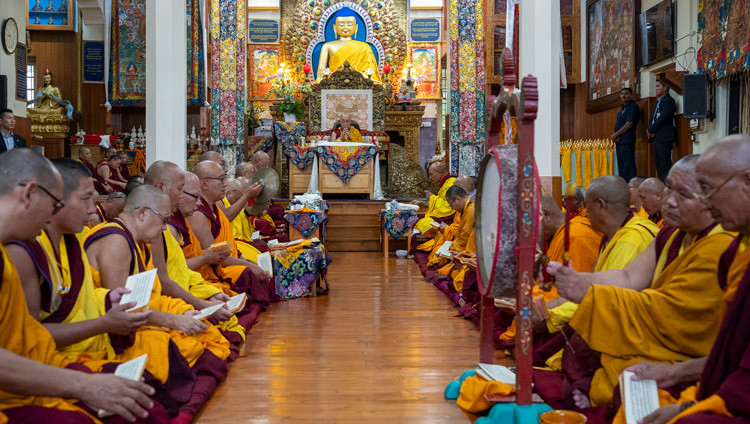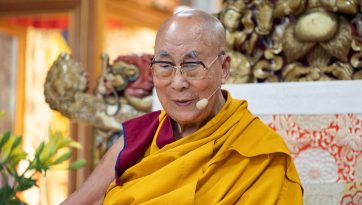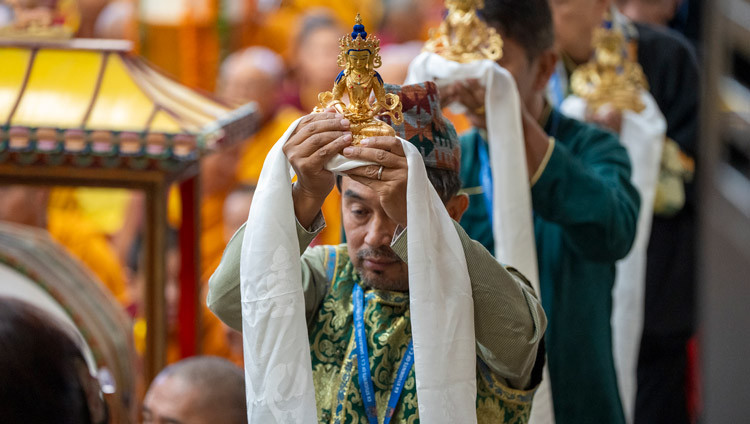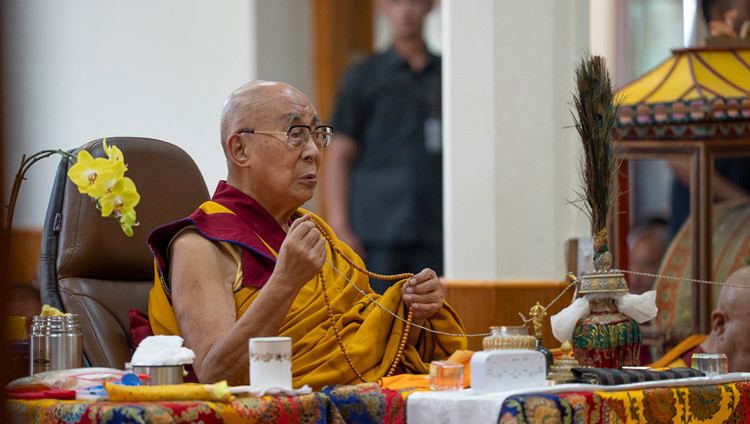A Second Day of Conversation with Young Peace Builders
October 24, 2019
Thekchen Chöling, Dharamsala, India – The group of youth leaders from countries disturbed by conflict and their supporters from United States Institute of Peace (USIP) who met His Holiness the Dalai Lama yesterday, gathered again in his audience hall this morning. When he entered the room, His Holiness wished everyone good morning and shook hands with those within reach.
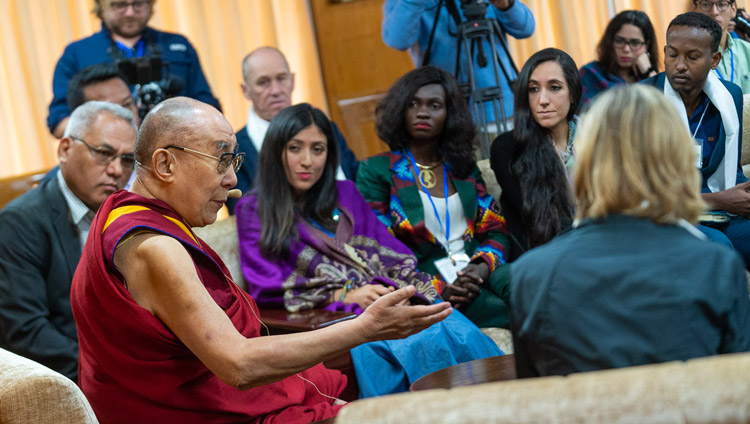
Nancy Lindborg, President of USIP and moderator of the conversation pointed out that each of the youth leaders present and those who have attended similar meetings in previous years, 106 altogether, have chosen to be peace builders. She told His Holiness that the focus of the first part of the morning’s discussions would be education.
To begin with, a young woman from Venezuela reported that people in her country were divided by hatred. She asked how to encourage forgiveness. His Holiness told her that between individuals taking revenge by killing again was of no use whatever. However, it may be helpful on a national or community level not to be tolerant of what has happened but to resist it. He cited the case of Poland where Lech Walesa, who he knows well, and the Solidarity movement, challenged communist power. Sometimes, he suggested, it’s good to stand firm in opposition to circumstances you don’t support.
He advised a youth leader from South Sudan, who expressed concern that the young among her people commanded little respect, not to worry about what their elders said. “When they witness the action you’re taking, they’ll be impressed.”
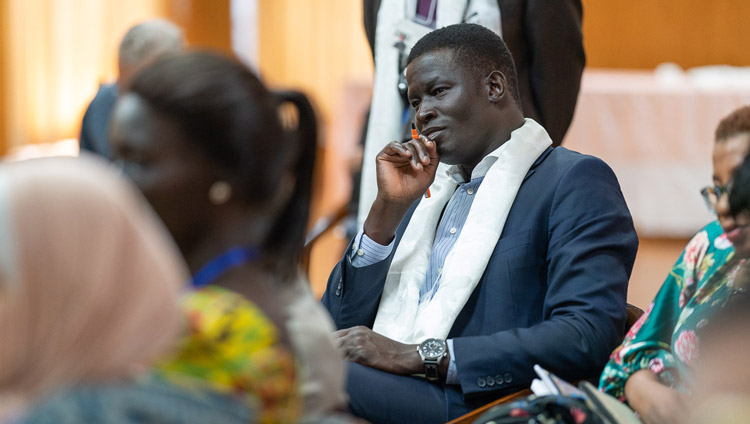
A peace builder from Afghanistan lamented village people’s opposition to education, especially for girls, and wanted to know how to counter such obstructive attitudes.
“Yesterday I mentioned that some long entrenched religious attitudes or social customs can be hard to shift,” His Holiness replied. “You need to work at it gradually and persistently and change will come. Trying to change things more quickly requires a revolution.”
A young Nigerian who had founded Ambassadors for Peace asked how His Holiness overcame resistance to his work as a young man. He told him he relied on educating the people involved, trying to give them a more realistic perspective. “When people are narrow minded and ill-informed the obstacle is ignorance, for which the only remedy is education. In 1962, when we published a democratic charter that included a clause about limiting the Dalai Lama’s power and again when I retired from political responsibility people were reluctant to accept it. I insisted.”
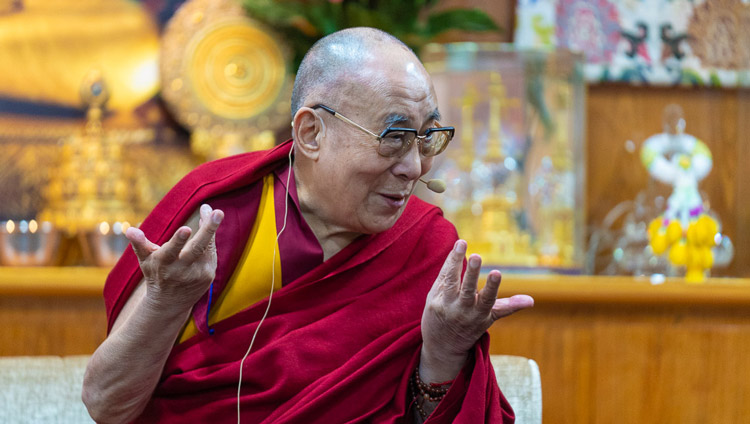
His Holiness advised a young Somalian that entering into dialogue and talking things through was the only proper way of restraining people intent on perpetuating violent conflict. He said it was important to make clear that in the 21st century old ways of thinking, such us dependence on the use of force, were no longer relevant.
He explained to a young Burmese that the Buddha gave different teachings to different audiences because of their different mental dispositions, which we respect. Therefore, we should also respect different religious traditions, no matter how apparently contradictory their philosophical views may seem.
A Colombian peace builder revealed that as a child she had been full of fear and was now concerned to know how we can train ourselves to develop a healthy heart and mind.
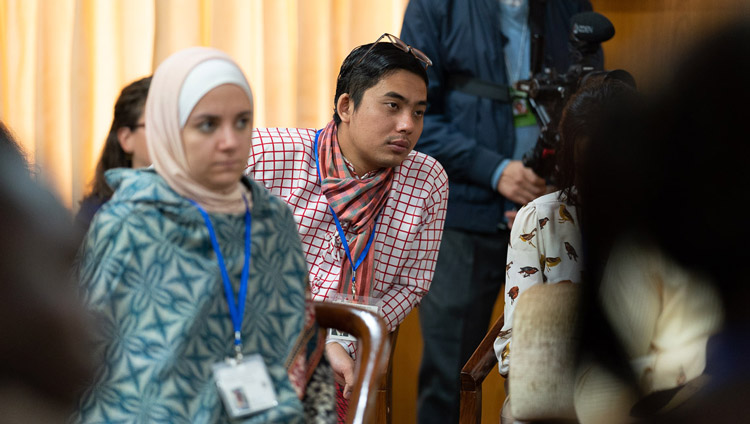
“First you need to find peace of mind within yourself,” His Holiness responded. “When your mind is too disturbed, it generates more problems. We are facing all kinds of problems—the world’s increasing population, global warming and the climate crisis, for example. Just thinking about them is not enough, we need to act. But to do that we have to assess whether there is a viable solution. The Buddha was explicit about the truth of suffering, but he also explained that suffering results from causes and conditions and that it is possible to put an to end it. An important first step is to acknowledge that there is a problem before you seek its solution.
“We have this unique human intelligence. We should use it to solve challenges we face, and never give up or tell ourselves there’s no hope. If you have a positive goal and you’re well-motivated to seek the well-being of others, no matter how difficult it is to achieve, you should remain determined. In the case of us Tibetans, because we seek solutions to our problems that are of mutual benefit, we have a reason to keep our strength up. You have to have self-confidence and to be truthful and honest.”
His Holiness explained that he takes profound inspiration from a verse written by an 8th century Nalanda master:
And now as long as space endures,
As long as there are beings to be found,
May I continue likewise to remain
To drive away the sorrows of the world.
He chuckled and added that the same master gave further practical advice—Why worry about something if it can be remedied? And what’s the use of worrying about something if it can’t be remedied?
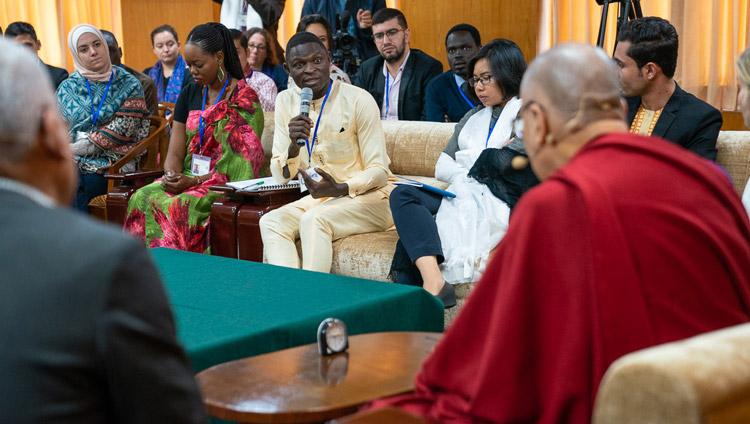
“It’s not enough to pray for peace of mind, you have to examine what disturbs your mind and eliminate it. Likewise, just wishing to be well won’t cure physical illness; you have to take the prescribed medicine. I have great respect for the Pali Tradition, which represents the foundation of the Buddha’s teachings. However, what I’ve learned from the Nalanda Tradition is the importance of using reason to examine the causes of what’s going wrong and finding ways to put a stop to them.”
Another peace builder from Sudan asked how His Holiness had encouraged his people to overcome their differences and work together. He replied that the strong influence of Buddhism and non-violence throughout Tibetan society made a great difference. Once upon a time, Tibetans had been as warlike as the Mongolians, but their encounter with the Buddha’s teachings made them more peaceful and amenable.
“These days,” His Holiness clarified, “many Chinese appreciate Tibetans’ fundamental non-violence. For the 120 thousand of us in exile, India is our spiritual home. We’ve got along well with the people we live among whether they are Indian, Swiss or American. Indeed, Tibetans have been valued for the pacifying influence their presence has brought to tribal areas of Orissa and even the city of Chicago.”
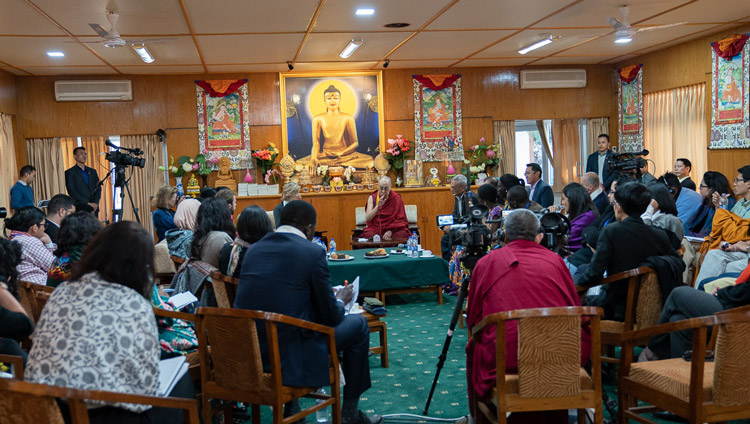
A Syrian youth leader from Damascus escaped to Turkey. Reflecting on the immense gratitude he felt, he asked how Tibetans have shown gratitude to their host countries.
“Our situation may be unique,” His Holiness observed. “In 8th century, Buddhism, specifically the Nalanda Tradition, was brought from India to Tibet and has been kept alive since then. Therefore, we have a special regard for India.
“When I first came to India in 1956, I made friends with President Rajendra Prasad, Vice-President Radhakrishnan and Prime Minister Nehru and many other Gandhians. When we later escaped from Tibet in 1959, these Indian officials were ready to accept us. On our part, we felt we had reached a country for which we had deep intrinsic respect, because Bodhgaya is here.
“With Government of India support we re-established our monastic education system, in which monks and nuns are able to study for 20 years or more. Now, I’m trying to revive interest in ancient Indian knowledge. I believe that India is the only country that might combine modern education with ancient Indian understanding of the workings of the mind—something the world urgently needs.”
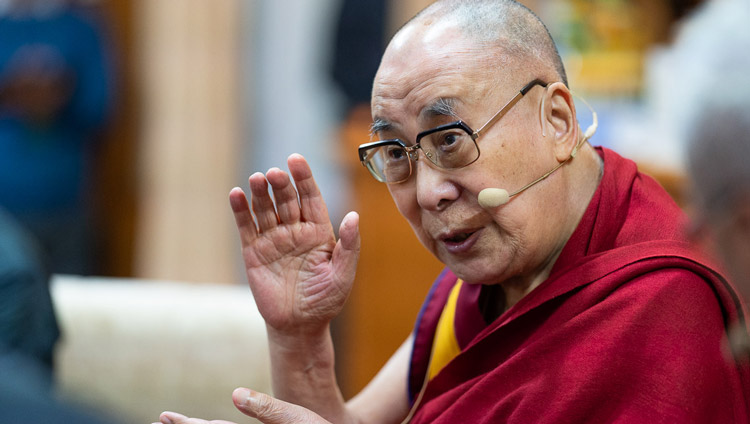
His Holiness answered a Colombian youth leader’s enquiry about how to promote peace, by pointing out that there is no good reason to be violent and very good reasons to be calm and compassionate.
A young woman from South Sudan wanted to know what role women had had in shaping His Holiness’s outlook. He told her that for most of us, our mother is our first teacher. In his own case, his mother had been the first person to demonstrate compassion to him. He remarked that since they are especially skilled in promoting compassion and human values, women should take a leading role in creating a more compassionate society.
He made light of an enquiry about his future reincarnation, suggesting that such institutions derive from a feudal era and are out of date. He admitted, however, that in his thoughts about his own next life, he draws inspiration from the First Dalai Lama, who dismissed the idea of taking birth in a heaven or pure land. Instead he expressed a preference to be born in a place of suffering where, as a human being, he could help others.
In response to a young Kurd’s asking how to keep up hope, His Holiness expressed admiration for the resilience of Kurdish efforts to maintain their culture and identity. He pointed out that we are now in the 21st century and no longer need to be bound by old ways of thinking. He looked forward to a time when all Kurds can be united in one place. He proposed that one way towards achieving such a goal would be the formation of a world body with the stature of the UN that, rather than representing governments, would actually represent peoples.
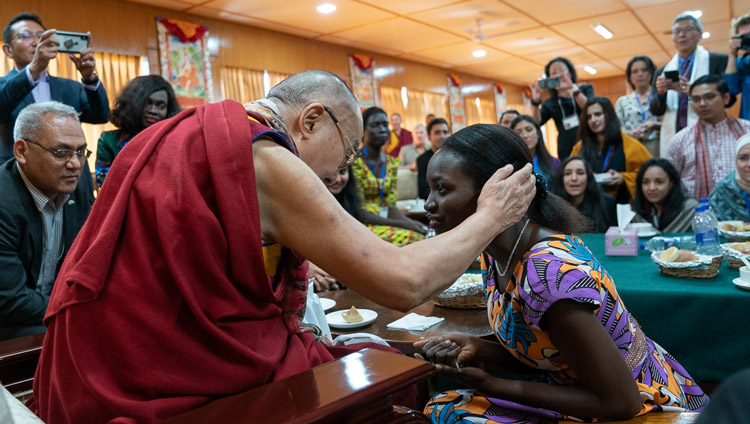
Nancy Lindborg brought the conversation to a close, telling His Holiness that she couldn’t thank him enough. She thanked the many people without whom the meeting could not have taken place.
“Time never stands still,” His Holiness concluded. “It’s always moving on. The past is beyond our control, but the future is still in our hands. To shape it we should use our intelligence and make efforts now. Although our present situation may not be happy, we can change it. There is no use in becoming demoralized. In the past, small communities could remain isolated and inward looking, but today technology has given us one human community in which we can work together. I look forward to positive change.”

